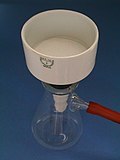Büchner flask
A Büchner flask (also called a vacuum flask, a filter flask, a side-arm flask or a kitasato flask) is a flask made of glass.
Structure
A Büchner flask has thick walls so that a pressure change will not break it. It has a hole in the top where a Büchner funnel can be put and a small tube in the side where a vacuum can be attached. The small tube has barbs on it so that the vacuum will not weaken.
Uses
A Büchner flask can be used with a Büchner funnel for separating solids and liquids. Water is poured into the Büchner funnel and the liquid passes through filter paper and is sucked up by a vacuum attached to the side of the Büchner flask, while the solid stays behind in the Büchner funnel.
The Büchner flask can also be used as a vacuum trap in a vacuum line to ensure that no fluids are carried over from the aspirator or vacuum pump (or other vacuum source) to the evacuated apparatus, or vice versa.
History
It is commonly thought to be named after the Nobel Laureate, Eduard Buchner, but it is actually named after the industrial chemist Ernst Büchner.
Büchner Flask Media
A Büchner funnel is attached to the flask via a black elastomer adapter. The hose barb is connected via vacuum hose to a vacuum source such as an aspirator. The flask should be clamped before use or the hose will likely cause it to tip.
Cross section of a Büchner Flask. Note the hose barb pointing right for attaching a vacuum source.
Related pages
Other websites
- A Büchner funnel manufacturer Archived 2007-07-14 at the Wayback Machine
- Experiment using Büchner funnels
- More examples of Büchner funnels


